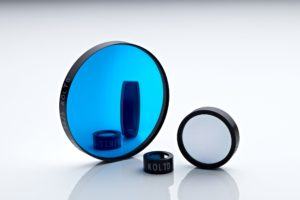UVC Sterilisation and Disinfection
 UVC light has been used for germicidal irradiation purposes for over a century, especially in medical facilities and laboratories. UVC light is considered to be between 100-280nm, but it is the waveband from 200 to 280nm that has been shown to be the most effective against pathogens such as bacteria and viruses. Though UVC light is emitted by the Sun, the ozone layers absorbs it. However, artificial UVC light can be produced and is utilised in systems that sterilise air, water and surfaces.
UVC light has been used for germicidal irradiation purposes for over a century, especially in medical facilities and laboratories. UVC light is considered to be between 100-280nm, but it is the waveband from 200 to 280nm that has been shown to be the most effective against pathogens such as bacteria and viruses. Though UVC light is emitted by the Sun, the ozone layers absorbs it. However, artificial UVC light can be produced and is utilised in systems that sterilise air, water and surfaces.
Optics play a large part in UVC sterilisation systems, and Knight Optical has been at the forefront of providing quality optical components to our customers. From stock optics for a quick turnaround to working closely with our customers on customised optical solutions. Contact our dedicated sales team for further information on how Knight Optical can help you with your optical needs.
Knight Optical has built an expansive portfolio of optical solutions within the UV sterilisation and disinfection market.
Optical Domes
Knight Optical is able to supply optical domes manufactured form UV fused silica, both as stock and custom options. We currently stock both 50mm and 100mm diameter domes. We can also provide custom dimensions to suit your specifications.
UV Moulded Optics
For more complex domes with, for example, an added flange for mounting, Knight Optical can also provide moulded optical components manufactured from specialist UV glass which transmits in the UVC regions.
You can find out more information on our UV moulded optical components here.
UV Filters
 UV filters and UV filter glass can be extremely beneficial in system where only certain wavelengths are desirable. Knight Optical can provide stock UV bandpass filters for certain wavelengths, however we can also provide custom bandpass filters which meet your individual specifications.
UV filters and UV filter glass can be extremely beneficial in system where only certain wavelengths are desirable. Knight Optical can provide stock UV bandpass filters for certain wavelengths, however we can also provide custom bandpass filters which meet your individual specifications.
You can find out more information on our UV filters here.
All optical components are tested in our state-of-the-art metrology laboratory to ensure they meet every specification, and then 100% visually inspected by our highly trained quality technicians. Knight Optical prides itself on the quality of our optical components, and you can be confident that our products will fit seamlessly into your UVC system.
Contact our dedicated sales team with your enquiry or for further information.
Additional Information
- A lot of care has to be taken when handling UVC light sources and systems, UVC light is harmful to humans as well as pathogens.
- With the increase in demand for small and compact UVC sterilisation systems, having the means to provide the solutions to our customers is essential. With moulded optical components, Knight Optical can now provide complex optics which house LED and LED arrays.
- Current UVC light sources work in areas from around 250 to 280nm, but there is focus on developing efficient light sources and optical components which work at 222nm as it still inactivates pathogens but is considerably less harmful to humans.
Light Sources
Low– pressure mercury lamps
These mercury lamps emit a single UV wavelength at 254nm (there are additional emission lines in the visible region). The gas mixture and mercury are usually encased in a fused quartz arc tube.
Excimer lamps
These Far-UVC lamps emit a transmission peak with a centre wavelength (CWL) within the UVC waveband, the CWL depends on the gain medium within the lamp, which consists of a gas mixture – usually a noble gas (such as krypton, argon or xenon) and a halogen gas (e.g. chlorine, fluorine or bromine). The laser gain medium determines the wavelength the laser emits at. Krypton bromide and krypton chloride are commonly used with wavelengths centred at 207nm and 222nm respectively.
Light emitting diodes (LEDs)
LEDS, and LED arrays, emit UVC light at a singular wavelength, currently 265nm, 273nm and 280nm. Compared to other sources, they have a higher output power which can significantly reduce the amount of time needed for sterilisation. Also due to their size, they are easier to integrate within a UVGI system and therefore the systems themselves can be more compact.
COVID-19
The COVID-19 pandemic has created a surge in research and manufacture of UV sterilisation systems. After research has found that UVC light does indeed inactivate the SARS-CoV-2 virus it became apparent that UV germicidal irradiation will be at the forefront of large-scale sterilisation operations.